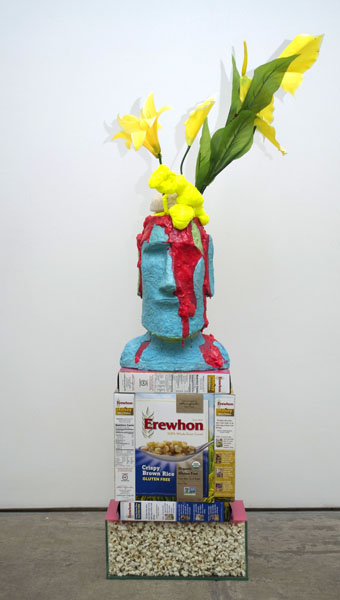Duchamp through the eyes of Koons, or just what happens when irony falls down the rabbit hole? I’m not quite sure, but Cyril Duval’s work has often piqued my curiosity. Years back I wrote a profile on himfor Clear magazine when he was launching Item Idem, and he happens to have a show up now at Johannes Vogt.

item idem Portrait of Mussolini as Prometheus, 2014
Planter, bubblegum, latex, foam, silk flowers, cereal boxes, acrylic, glass container, popcorn
10 x 22 x 55in (25 x 56 x 140cm)
Duval’s very smart in a resourceful, wily sort of way, as it seems is his partner-in-crime these days, Babak Radboy, who explains their current project, “Shanzai”, a faux art fair, in Art in America as such:
“The phenomenon of shanzhai is deterritorialized at its core—in the same way that a global art market is so obsessed by and so based on territorial expansion, but at the same time has very little to say about the places that it’s in. Whether it’s the Gulf or Istanbul or Baku or China, it’s all Ubers and hotels. The idea of trying to turn something like shanzhai into a place makes a lot of sense.
The way we operate is really based on invitation and opportunity. All of us in some way or another are annoyed at a kind of traditional studio practice and the idea of warehousing art products and labor and waiting for someone to happily discover you, like you’re a mineral resource or something. We really work around the opportunities that present themselves to us. Everything we do is made up for that specific venue, including press—when we have a large article or review coming up we’ll invent the documentation for a piece that maybe didn’t happen.”
I’m not sure what to make of it – the inevitable post-internet conflation of satire with admiration, the knowing consumer’s predicament? – but for those in London this week, check it out and let me know (especially if it “didn’t happen” ). Here’s the press release, and if you want more, check out this feature in V magazine:
SHANZHAI BIENNIAL N°3: 100 HAMILTON TERRACE
Monday Oct. 13th, Project Native Informant, London
Tuesday Oct. 14th, Frieze Projects (Live), booth L1, London
ART PRESS RELEASE:
For it’s third Biennial in as many years, SHANZHAI BIENNIAL will attempt to sell a £32,000,000 estate at Frieze Art Fair, London — for which they stand to make a healthy commission.
Entitled SHANZHAI BIENNIAL N°3: 100 HAMILTON TERRACE, the work consists of twin retail installations running concurrently at Frieze and the gallery Project Native Informant. Featuring a high-gloss advertising campaign in stills and video dispersed in a half dozen prominent press outlets but in the end culminating less in these traces than in the potential commercial transaction they seek to perform.
Transforming both their gallery and their prominently placed booth at Frieze into fully functioning real estate boutiques, SB has partnered with high-end brokerage Aston Chase in the crafting of a advertising strategy which unlocks the potential of Frieze as a lifestyle brand with a rarified demographic penetration uncannily suited to the London property market.
Taking the iconography and phenomenon of Frieze itself as their starting point, SB responds to an environment of intensely subdivided space, in which a labyrinth of booths recreates in miniature a global landscape of private galleries in an almost platonic representation of the dynamics of culture and commerce.
The fair has coincided with an epoch for the popularity and usefulness of contemporary art — which has itself become indispensable to the industries of property development, place-branding and ‘reurbaniziation’. The magazine from which it sprang also operates as a rentier of cultural space: producing a publication defined as a space for critical discourse; practically supported through the sale of advertisements. Advertisers effectively pay for space for its proximity to critique.
With it’s crypto-corporate identity evoking limited ethical liability SHANZHAI BIENNIAL decants the space afforded critique as a mediator of culture and commerce by directly profiting not only from the sale but also the production of its work.
With 100 HAMILTON TERRACE, SHANZHAI BIENNIAL squarely leaves the round of artists working within the framework of corporate aesthetics and positions itself as a commercial entity exploiting the art world in a mutually beneficial exchange of services. In the end the biggest winner is the public.


